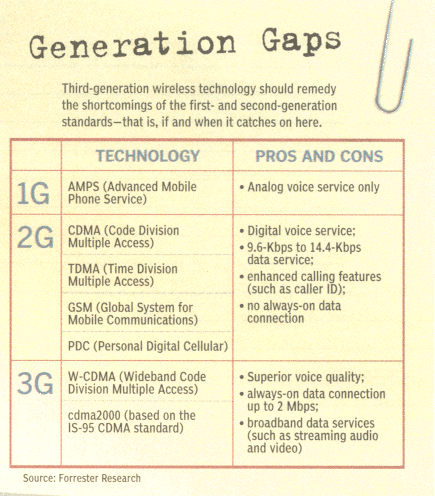
CELLULAR MODEM |
wireless cell cellular modem for data access solutions
This low cost combination of a modem & cell phone is ideal for those " remote remote" sites where a phone line is impossible.
With the cost cellular service declining a cell modem makes sense for Utility and Industrial applications.
AMPS Advanced Mobile Phone Service
The first cellular networks where analog systems. The Advanced Mobile Phone Service (AMPS) is in wide use even today, almost 25 years after it was introduced. AMPS was conceived by Bell Labs in the 1970s,. The AMPS air interface is specified in EIA/TIA-553. AMPS is based on FDMA.
The FCC allocated a total of
50 MHz (25 MHz on the A side and B side) in the 800-MHz spectrum for AMPS. Each
voice channel is allocated a 30-KHz portion of the bandwidth within the AMPS
frequency allocations. Which limits the number of channels for voice traffic to
312 calls at one time? AMPS uses the seven-cell frequency reuse method. Control
channels are used to set up and clear calls as well as other control messages.
Each band (25 MHz) contains 21 control channels. When a mobile station is not in
session, it must monitor designated control channels. It tunes and locks into
the strongest channel to receive system information. The forward control channel
(FOCC) is a data stream from the base station to the mobile, and the reverse
control channel (RECC)
is from the mobile to
the base station. Voice conversation is carried over the forward voice channel (FVC)
and the reverse voice channel (RVC)..
The
ESN
(Electronic
Serial
Number)
for a mobile is a 32-bit number that uniquely identifies a mobile and is set up
by the mobile manufacturer.
The system IDs
SID
(System
IDentification)
is a 15-bit binary numbers that are assigned to cellular systems. One of the
uses of the SID is to determine a home network from a roaming network.
The MIN (Mobile Identification Number) is a 34-bit number that is derived from the mobile terminal's 10-digit telephone number.
Data services in AMPS are straightforward and analogous to dial-up net-working. Because AMPS is an analog technology, it is possible to make use of standard modems directly with AMPS. Data rates are at a maximum of 14.4 Kbps irrespective of the modem protocol (v.90 or others).
|
Wireless Data Analog Cellular modem and |
|
ARC
AC/DC powered CDL-900 |
|
BlueTree |
|
Telenetics OMEGA-1 AC/DC
powered |
|
AIRLINK
CDPD |
|
Data
Remote |
ARC ELECTRONICS
a DCE Company
jump to ... Home Page
Digital RS232 CDMA and GSM-GPRS cell modem /
cellular modem for data access solutions
820-850Mhz and 1.9Ghz Band - digital cell modem Dual-band and Tri-band
|
jump to Digital cell modems
jump to Cell modem terms Glossary
|
2G-3G
Cellular Wireless What is Throughput X-Cellerator TX-Cel Here are some links of interest: The CDMA Development
Group |

What is CDPD
CDPD (Cellular Digital Packet Data) is a specification for supporting wireless access to the Internet and other public packet-switched networks. Cellular telephone and modem providers that offer CDPD support make it possible for mobile users to get access to the Internet at up to 19.2 Kbps . Because CDPD is an open specification that adheres to the layered structure of the Open Systems Interconnection (OSI) model, it has the ability to be extended in the future. CDPD supports both the Internet's IP protocol and the ISO Connectionless Network Protocol (CLNP).
CDPD also supports IP multicast (one-to-many) service. With multicast, a company can periodically broadcast company updates to sales and service people on the road or a news subscription service can transmit its issues as they are published. It will also support the next level of IP, IPv6.
For the mobile user, CDPD's support for packet-switching means that a persistent link isn't needed. The same broadcast channel can be shared among a number of users at the same time. The user's modem recognizes the packets intended for its user. As data such as e-mail arrives, it is forwarded immediately to the user without a circuit connection having to be established. There is a circuit-switched version, called CS CDPD, that can be used where traffic is expected to be heavy enough to warrant a dedicated connection.
as you may well know the FCC
has let the carriers discontinue the CDPD networks
which are now being replaced by the GPRS and 1xRTT digital networks that run on
the IP networks
Jump to other wireless solutions
ARC ELECTRONICS
a DCE Company
301-924-7400 EXT 25 x 17
e-mail Sales at drowe@data-connect.com
jump to ... Home Page